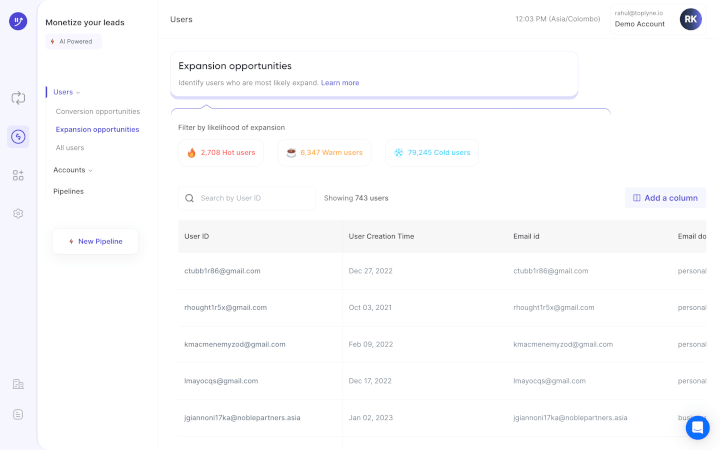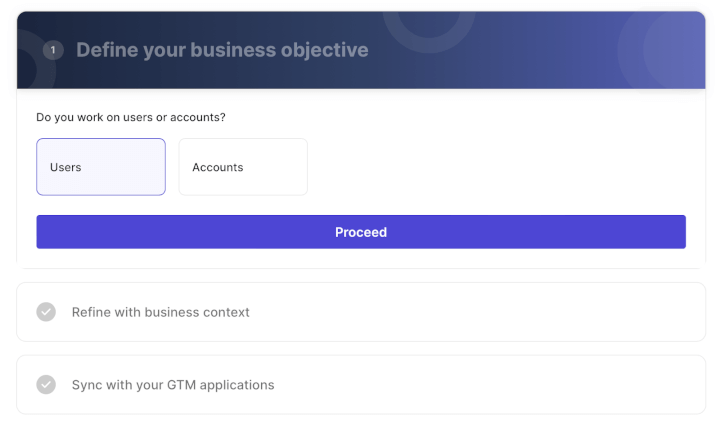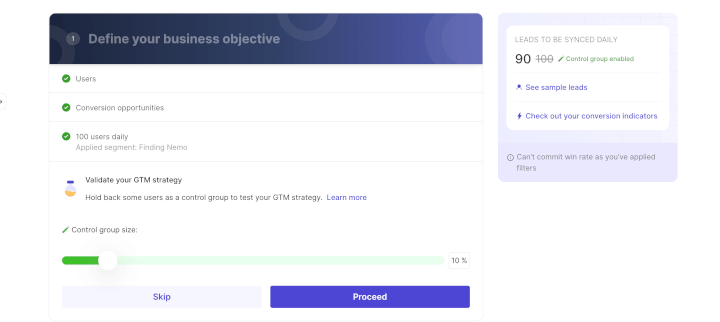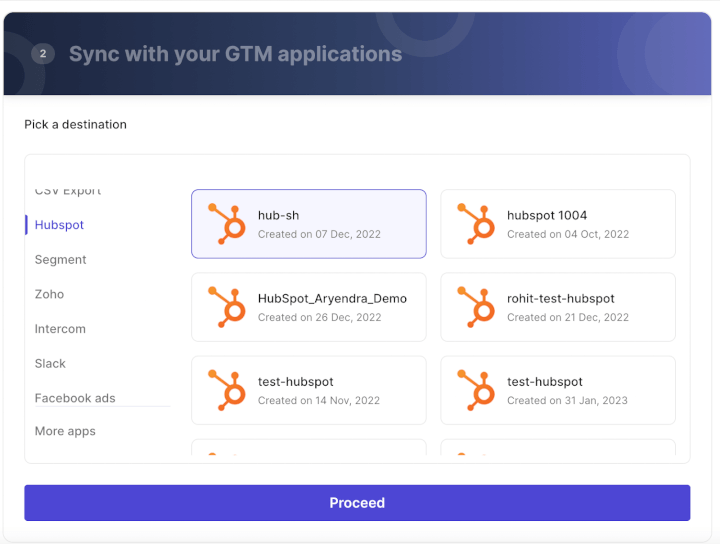How To Create A Successful Lead Scoring Matrix

Blue pill: Your lead generation marketing campaigns are working spectacularly 🔵💊
Red pill: Only one of them is a Sales Ready Lead 🔴💊
But what if we told you there’s a way to:
- Determine which potential customer is most likely to buy 💰
- Optimize lead generation campaigns to catch ONLY high-quality leads 🎣
Enter: Lead scoring matrix — the ultimate lead scoring system.
With a lead scoring matrix, you can accurately identify a potential customer and connect the dots across their lifecycle, helping your sales team prioritize high-quality leads.
So, are you excited about creating a fail-proof sales funnel?
Let's shake hands on that!

In this article, we’ll find out what a lead scoring matrix looks like, how you can build your own in four simple steps, and five methods to calculate a leads score.
We’ll also introduce you to The One lead scoring tool that can make your lead qualification dreams a reality!
Let’s enter the matrix! 🕶
What is a Lead Scoring Matrix?
Think of a lead scoring matrix as a lead grading or scoring system that helps your sales rep focus efforts ONLY on a sales ready lead.
How does it work? 🤔
It assigns a point value based on firmographics, engagement attributes, or behavioral scoring.
Look at it this way — if Lead A ticks 9 out of 10 boxes but Lead B ticks only 3 out of 10 of your lead scoring model, it’s easy to tell that Lead A is a more qualified lead than Lead B.
But here’s the kicker: you’ll get a visual representation of the perceived point value for each prospect.
That means your sales rep or digital marketing team can easily spot a qualified lead 🎯

How can you benefit from this?
Let’s look at three awesome benefits of a lead-scoring matrix:
- Boost productivity and revenue: This is a no-brainer. If your sales team only focuses on a marketing qualified lead, you can boost overall productivity and increase conversions and revenue 🚀
- Identify common successful patterns: Say goodbye ✋to guesswork. A lead-scoring matrix allows your marketing team to spot the best campaigns, marketing channels, and common patterns that result in high-quality leads.
- Provide sales and marketing with clear foresight: That’s right! A lead scoring matrix allows you to create several rules to help you prioritize a marketing qualified lead.
Ready to step into the Matrix?
Make sure you train well on how to navigate it first!
Four Step Guide For Building Your Lead Scoring Matrix
A lead scoring matrix will give your sales and digital marketing teams Neo-like superpowers to score and convert top-quality leads.

Follow these lead scoring best practices to tap into your inner Neo:
1. Create Your Buyer Persona
All you see before you is a sea of potential customers.
But here’s the deal…

Morpheus is right — not everyone is your ideal customer.
To fully understand your buyer persona, you’ll need to ask questions like:
- Who are my ideal customers?
- What are their key pain points?
- What type of solutions are they seeking?
- Which channels or platforms do they use?
- At what point does their interest peak?
- What do they like about my product or service?
Here’s how you can gather all this information:
- Talk to your sales team: Since your sales team is talking to your customers directly, they have a great idea of what leads usually convert.
- Float out a customer survey: When figuring out your ideal customer, who better to ask than those using your product? Conduct a few interviews 📝 and understand what makes them tick.
- Analyze marketing data: Compliment your in-person research with factual marketing data 📈. This will tell you which marketing efforts and channels convert and which don’t.
2. Figure Out Your Lead Scoring Criteria
Morpheus always knew who his Neo was.
Too bad marketers don’t have it that easy. 😞
You’ll need to work hard on defining your lead qualification criteria.
Get started by defining:
Explicit Lead Scoring criteria that predominantly reveal a user’s demographics and firmographics based on:
- Industry or business sector
- Business location
- Company name
- Number of employees
- Annual revenue
- Lead source
- Job title or level of responsibility
- Purchase authority
- Past purchases or products/services they currently use
Implicit Lead Scoring criteria that mostly reveal prospect's engagement and interest levels based on:
- In-app actions
- Pricing page views
- Response to phone calls
- Content interactions
- Online subscriptions
- Webinar attendances
- Form completions
Negative Lead Scoring shields you against cold leads or non-prospects.
Think of actions like:
- Lack of response to marketing messages
- Unsubscribing from newsletters or other emails
- Registering a do-not-call request
- Lack of decision-making authority
- Long periods of inactivity
- Visiting non-product related pages like the careers page
This way, you can stop low-quality leads from entering your sales funnel — with precision ✋

3. Identify Your Ideal Lead Score
Not a fan of math?
Not to worry — you don’t need to be The Analyst to figure out your ideal lead scores!

(He’s talking about Math.)
All you need to do is assign appropriate values to your prospect's online or in-product actions.
And voila! You’ll be able to spot only the hottest leads! How?
It’s simple:
- Use a 0 to 10 scoring scale for your explicit and implicit lead scoring criteria
- In contrast, use a -10 to 0 for the negative scoring criteria
The cumulative score will point you in the direction of your ideal customer.
4. Automate Your Lead Scoring Model with the Best Tech
Let’s face it:
An automated lead scoring system vs a manual one is like the red and the blue pill.
You can either embark on a life-changing experience or … need we say more?

Let us explain this a little further:
Using marketing automation for a lead scoring process can:
- Eliminate human error
- Boost your sales and marketing team’s productivity
- Effectively reach out to hot leads and nurture them
- Scale your sales growth rapidly
But, more importantly, you’ll get access to comprehensive dashboards, in-depth reports, and accurate emerging trends.
The best part: you get all of this with just a few 🐁 clicks.
Psst! Toplyne is an AI-powered predictive lead scoring platform that allows your sales and marketing teams to spot the right leads and get mouthwatering insights.
Five Popular Methods for Calculating a Leads Score
The Architect has his versions of the Matrix, and marketers have their lead scoring models.

And that’s why we’re here!
Let’s learn more about all five lead scoring models and which one’s the best choice for you:
1. Manual Lead Scoring
With manual lead scoring, you can choose different attributes from your lead scoring criteria and assign values for each action to calculate the final lead score.
But this system has more cons than pros, like:
- It’s more focused on eliminating bad leads than identifying good ones
- It can’t adapt automatically, limiting companies in fast-changing markets
- It doesn’t allow your sales team to provide real-time feedback
Crucially, it’s based on personal judgment, so individuals within your organization may use different attributes and assign varying scores for the same prospect.
The human-dependent nature of this model makes it unfit for when your sales reps are having a rough day.

The bottom line?
While this lead scoring model is a good start, you'll find it difficult to maintain accuracy ❌ and scale in the long run.
2. BANT Lead Scoring
BANT is an old-school lead grading methodology (originally conceived by IBM) designed to identify worthy leads.
These lead scoring criteria will help you analyze four critical aspects of the buyer journey:
- Budget: Does your prospect have purchasing power?
- Authority: Are they the decision-makers?
- Needs: What solutions are they seeking?
- Timeline: At what stage are they likely to purchase?
A prospect that meets three of these requirements is considered a promising lead — unless they don't meet the budget criteria. 🚫
3. Logistic Regression Lead Scoring
Thanks to complex data mining techniques in this lead scoring model, it can predict your lead generation and sale conversion rate with far more accuracy.
However, you’ll need to work out an Excel formula for this lead scoring process.
And that can sometimes feel like analyzing the Matrix code!
Over time, the predictive score only gets smarter, which allows your sales and marketing teams to engage with the right prospects at the right time.
4. Einstein Lead Scoring
Einstein lead scoring combines machine learning and data science.
The lead scoring AI then analyzes all the data point sources to create a predictive model based on common patterns in converted leads.
But wait, there’s more.
This AI-powered model reanalyzes lead data every ten days, helping you spot emerging trends.

5. Predictive Lead Scoring
There’s someone out there who knows the future.

The predictive scoring model can forecast conversions with mind-blowing accuracy reminiscent of the Oracle.
Why?
It predicts industry-specific lead quality based on a larger data pool or scoring system, including
- Big data point sources
- Historical data
- Emerging trends
It’s an automated lead scoring system that creates a qualified lead profile using the information (like lead scores) of your past and existing customers
- It also identifies leads most likely to convert by scoring them against the lead quality profile
- But the real icing 🎂 is that a predictive scoring model understands and registers these common patterns
But what if we told you there’s a NEO-LIKE tool that can do all of this and more?
Introducing: Toplyne — The One you’ve been looking for to make you lead scoring matrix dreams come true.
Think Outside the Box with Toplyne 😉
Toplyne is the Trinity to your Neo — the perfect partner for your sales team!
Here’s what Toplyne can do for you:
- Build a smooth funnel of product-qualified leads
- Boost your win rates dramatically
- Spot conversion and expansion opportunities, improving your overall NRR (net revenue retention)
How?
Toplyne not only shows you the door, but it also helps you walk through it (just a little sweeter than Morpheus) 😇
It does this by combining:
- Your product and user analytics data sources like Amplitude, Mixpanel, Segment, Rudderstack, etc., AND
- Your sales workflow tools like Salesforce, Hubspot, etc.
Sounds good?
Here’s how companies like Canva and Vercel generate sales pipeline from their self-serve funnel using Toplyne:
- Step 1/7: Create monetization playbooks to surface conversion and expansion opportunities (leads most likely to convert to paying customers, and teams most likely to grow into larger teams)

- Step 2/7: Choose the right leads to target – users (individual users) or accounts (a group of users with an organization).

- Step 3/7: Select the frequency at which you would want leads synced in your GTM apps.

- Step 4/7: Define how many leads you want by either the number of leads or your expected win rate, depending on your sales capacity and GTM strategy.

- Step 5/7: Build custom segments - Build custom segments based on And/Or logic at the deepest level of sub-properties within your product analytics.

- Step 6/7: Validate your GTM strategy - Hold back some users as a control group to test your GTM strategy.

- Step 7/7: Sync your product qualified pipeline into your GTM destinations - CRMs, sales & marketing execution tools, and customer engagement platforms.

The bottom line:
With Toplyne, your sales team can focus on converting a top-quality lead and improving the company’s bottom line! 😉
As a result, you’ll be able to scale your revenues — much like pros such as Canva, Invideo, and Granfa labs. We keep good company!
Enter The Lead Scoring Matrix! 🕶

Without a lead scoring matrix, finding top-quality leads is like looking for a needle in a haystack — or patterns in the Matrix code!
Moreover, keeping up with emerging trends in the hyper-digital world makes the task even more difficult.
Fortunately, a unique tool like Toplyne can help you set aside these worries, channeling your energy towards more conversion and expansion opportunities.
So, are you ready to enter the spectacular world of top-quality leads?
Sign up for Toplyne for free today, and you could be “The One” to scale your company's revenues!


.svg)









.png)